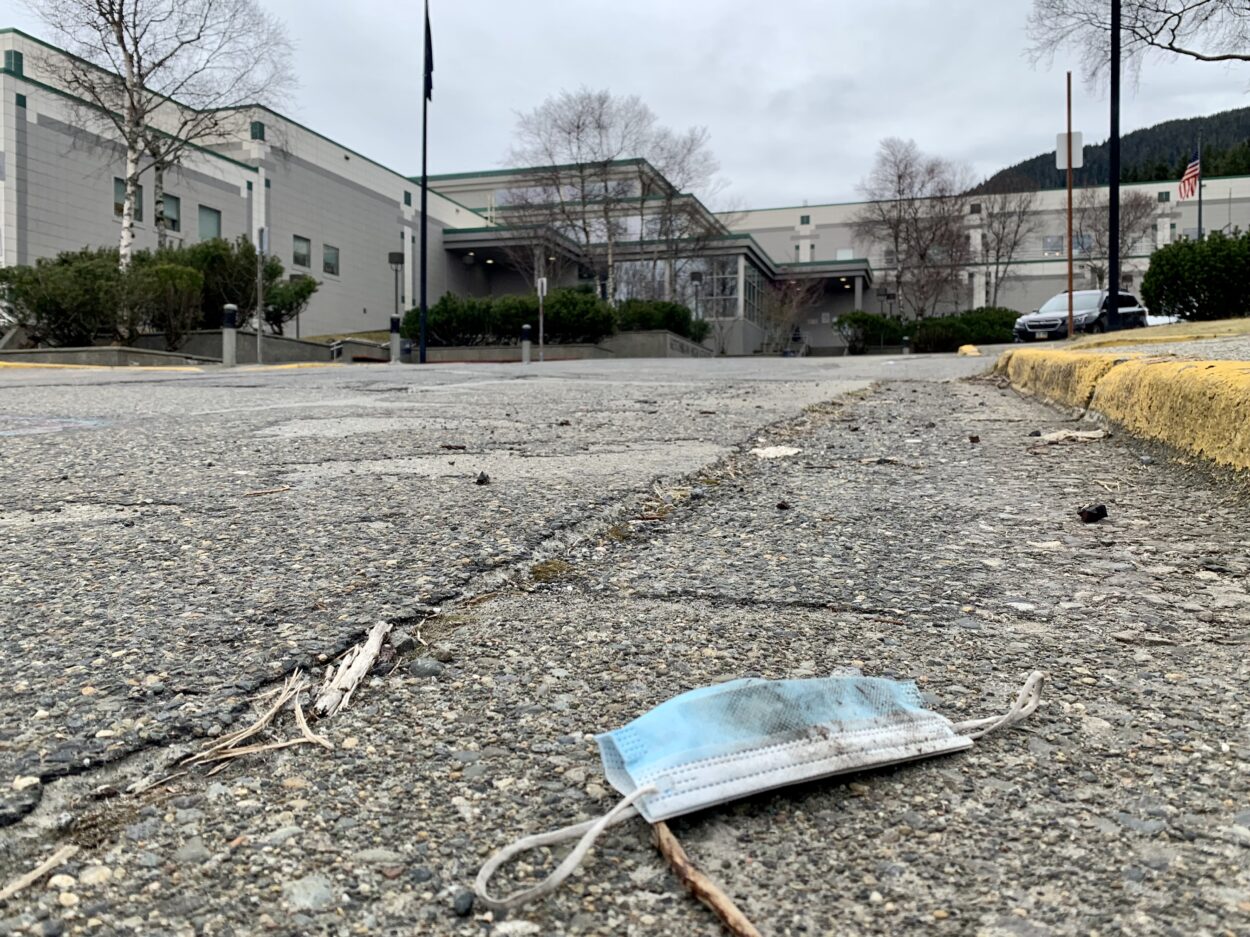
A discarded mask lies on pavement outside Ketchikan High School on Tuesday, Feb. 22, 2022. (Eric Stone/KRBD)
Monday marked the first day since the pandemic began that Ketchikan students have been allowed to attend classes without masks.
COVID-19 cases have fallen sharply in Ketchikan since the height of the omicron surge early this year. While state health authorities still say there’s a high risk of COVID-19 spread in Ketchikan, looser guidelines implemented by Ketchikan’s school board last year mean students no longer have to wear masks at school.
Ketchikan’s school board is scheduled to vote Wednesday on a proposal that would roll back nearly all of the district’s COVID-19 precautions — and allow students who test positive but don’t have symptoms to attend school unmasked.
Ketchikan’s school district reported just 12 cases of COVID-19 last week. And under the school district’s four-level COVID-19 plan, that means masks are now optional at Ketchikan’s eight public schools.
Most high school students KRBD interviewed over lunch on Tuesday welcomed the move.
“I’m happy I get to see my friends’ faces, finally. I can breathe, so I feel more alive,” said sophomore Alexander Gilley.
“If COVID levels get worse, then masks should be required again, but I think it’s kind of nice and refreshing, I guess, seeing everyone,” said freshman Ella Shull.
“I’m personally fine with it. I wear masks around the school still, but I’m not going to harass anyone for their option,” said sophomore Nicholas Karr.
Registrar Rhonda Bolling says she’s glad to see masks optional in school.
“Every kid I see, I’m like, ‘Oh my gosh, it’s so wonderful to see your beautiful smile,'” she said.
In a survey conducted earlier this school year, students tended to favor looser mask requirements, whereas teachers and staff tended to prefer stricter mask rules.
If cases rise again, masks would be back. But that could change if there’s a shift in policy.
On Wednesday, Ketchikan’s school board is scheduled to consider lifting nearly all COVID-19 restrictions at all district schools. In other words, masks would be gone for good.
“The proposal is to make masking optional at all levels, and to cease the practice of sending home kids who aren’t sick,” said school board member Paul Robbins Jr. in a phone interview on Tuesday. He’s sponsoring the proposal.
“I’m basically trying to make it to where we’re starting to treat this COVID illness and its new variant, which is not nearly as harmful as the previous ones, as we do other sicknesses: If kids have symptoms, then they go home. If they don’t have symptoms, then they stay in school,” Robbins said. “We shouldn’t be removing children from the classroom who aren’t sick.”
He says the district should not send home students who test positive for COVID-19 but do not show symptoms.
“If a kid gets tested and has COVID — has a positive test — regardless of whether they’re actually sick or not, they need to go home under the current policy,” he said. “And that’s what we’re trying to change is, if they’re not symptomatic, if they’re not sick, then they shouldn’t be going home. And that goes for teachers or students.”
But what does it mean to be sick, per se? And can people without symptoms still spread the virus?
Public health nurse Arizona Jacobs says yes.
“Bottom line is yes, infected people can transmit the virus both when they have symptoms and when they don’t have symptoms,” she said.
She says there’s a seven-day window during which people are at their most contagious.
“People are most infectious two days prior to symptom onset or a positive test and five days from symptom onset or a positive test,” she said.
She’s encouraging Ketchikan’s school board to take it a little slower.
“I just want to caution people from rolling back too many at one time,” she said. “Let’s be thoughtful about this. Let’s do this one at a time, and then maybe we don’t need them back.”
Dr. Timothy Horton at PeaceHealth Medical Group in Ketchikan says it’s not uncommon for people without symptoms to be contagious.
“About 45% of people that spread it are asymptomatic themselves,” Horton said.
A Centers for Disease Control modeling study estimated an even higher figure: 59% of transmission could be attributed to people without symptoms. That’s in part because people who are asymptomatic are less likely to stay home from work or school.
The Ketchikan pediatrician says federal guidelines seek to balance the risk of spreading COVID-19 against the benefits of in-person work or school. He points to the Centers for Disease Control and Prevention’s recent decision to shorten isolation recommendations to five days as an example.
Jacobs, the public health nurse, says removing all COVID restrictions might make it difficult to reimpose them if it turns out they’re needed again.
“And it’s also really hard to put some of these things back. So if we take masks away completely, can we ever put them back? If we are facing a massive outbreak of a far more deadly variant, can we put them back?” she said.
Paul Robbins Jr, the school board member who wants to end masks, says yes. If there’s a surge in cases, or a more dangerous strain arose, the school board could always change the rules – again.
“We could have a special meeting or the superintendent could simply email the board to make adjustments to the Start Strong plan and it can be approved. What I’m doing is making sure that we’re not unnecessarily removing kids from school under the current variants we’re dealing with,” he said.
Ketchikan’s school board is scheduled to consider the proposal on Wednesday. The board meets at 6 p.m. in the White Cliff Building. The meeting is live-streamed online and on local cable channels, and there’s time for public comment at the beginning of the meeting.





